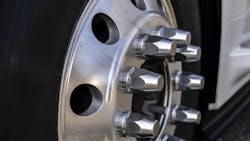Steer-axle specs must be followed—or safety is put at risk
The trucking industry is one of the most regulated in North America—and rightfully so. When an 80,000-lb. tractor-trailer is traveling at 65 mph, the potential for disaster is constant, regardless of the cargo it’s carrying. Recent weather-related pileups on interstates are evidence of what happens when a fully loaded or empty commercial motor vehicle loses control at speed.
Besides ice and fog, nothing strikes fear into the heart of a truck driver like a steer-axle tire failure. I’ve changed a few on the side of the road, and the drivers were always grateful that they were able to get the vehicle under control after the blowout. While there is no scientific data to prove this, my personal opinion is that steer tires are the best maintained tires in the fleet because drivers pay the most attention to them. If a drive or trailer tire fails, it usually isn’t a big deal. The same cannot be said for steer-tire failures, so they are typically inspected more closely and more frequently.
See also: Tire outlook for 2023
The steer position is without a doubt the most complicated application for tires on a vehicle. Tag, drive, and trailer axle tires don’t have as many lateral forces, so they don’t experience the type of stress that occurs on the front axle. Steer tires don’t have backups, unlike drive and trailer positions. In many cases, a driver may be unaware that a failure has occurred on the rear of the vehicle or chooses to continue driving until they reach the next rest area because they can. There are no options when a tire fails on a front axle.
One reason for failure is overloading. Every axle on every vehicle has a gross axle weight rating. The GAWR reflects the maximum amount of weight that the axle can safely support while in operation. While front-tire failure is bad, front-axle failure is probably worse because even with a flat tire on the steer position, the driver can maintain some degree of control. Axle failure can be an incredibly costly/tragic lesson in physics when tons of vehicle and cargo are completely out of control at highway speeds.
It’s so important that the federal government first passed a law back in 1977 regarding the relationship between a GAWR and tires on commercial motor vehicles. According to 49 CFR § 571.120, “the sum of the maximum load ratings of the tires fitted to an axle shall be not less than the gross axle weight rating (GAWR) of the axle system as specified on the vehicle’s certification label required by 49 CFR part 567.”
For steer-axle tires, this regulation can create a serious issue for some vehicles. The most popular commercial truck tires are the 295/75R22.5, the 275/80R22.5, and the 11R22.5, each with a Load Range G. All of these tires have the same maximum carrying capacity of 6,175 lb. Trucks with a 12,000-lb. GAWR on the front axle can run those sizes in that load range in total compliance. If the front axle GAWR increases to 12,350 lb., compliance with 571.120 still is guaranteed.
See also: Time to bust tire inflation-pressure myths
However, if the GAWR on the front axle is 12,500 lb., then a Load Range H tire is necessary. It doesn’t matter how much weight is actually carried on the front axle during operation. It is very clear in 571.120 that the sum of the maximum loads for the tires cannot be less than the GAWR for the axle position listing on the certification label. An extra 150 lb. doesn’t seem like much of a safety issue and probably isn’t, but the regulation only allows exceptions for vehicles with “a speed attainable in 3.2 kilometers of 80 kilometers per hour or less,” which is basically 50 mph in 2 miles.
More commercial tire dealers are training their technicians to check the certification label before replacing steer tires to make sure they are compliant with 571.120. While the third-party installer will not be issued a citation after noncompliant tires are installed, they will be held accountable if steer tires fail for any reason and cause an accident.
The plaintiff will point to the failure to comply with federal regulations as another way the installer (third-party or fleet) did not follow the standard of care for replacing steer tires on commercial motor vehicles. Trucks with 12,500-lb. front axles require the Load Range H tires (which may be more expensive) when the three most popular 22.5-inch sizes are specified on the certification label. It's not an option.
About the Author
Kevin Rohlwing
Kevin Rohlwing is the SVP of training for the Tire Industry Association. He has more than 40 years of experience in the tire industry and has created programs to help train more than 180,000 technicians.
